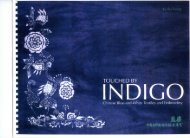Fossil Matching Game Fossils are our only clues to life in the past ...
Fossil Matching Game Fossils are our only clues to life in the past ...
Fossil Matching Game Fossils are our only clues to life in the past ...
Create successful ePaper yourself
Turn your PDF publications into a flip-book with our unique Google optimized e-Paper software.
<strong>Fossil</strong> <strong>Match<strong>in</strong>g</strong> <strong>Game</strong><br />
<strong>Fossil</strong>s <strong>are</strong> <strong>our</strong> <strong>only</strong> <strong>clues</strong> <strong>to</strong> <strong>life</strong> <strong>in</strong> <strong>the</strong> <strong>past</strong>. They help us learn about evolution - how liv<strong>in</strong>g th<strong>in</strong>gs have<br />
changed through time. <strong>Fossil</strong>s <strong>are</strong> like a pho<strong>to</strong>graph of an animal at a particular po<strong>in</strong>t <strong>in</strong> <strong>the</strong> his<strong>to</strong>ry of <strong>the</strong><br />
Earth.<br />
<strong>Fossil</strong>s also help us understand what k<strong>in</strong>ds of environments existed millions of year ago. For example, by<br />
study<strong>in</strong>g fossils, paleon<strong>to</strong>logists have learned that 440 million years ago, Ontario was covered by a warm,<br />
shallow tropical sea full of corals, trilobites, sea lilies, clams, and o<strong>the</strong>r creatures. Imag<strong>in</strong>e that!<br />
Some ancient animals, such as trilobites, have no close liv<strong>in</strong>g relatives. O<strong>the</strong>rs have very close relatives<br />
liv<strong>in</strong>g <strong>to</strong>day. By study<strong>in</strong>g liv<strong>in</strong>g animals and how <strong>the</strong>y live, scientists can better understand how animals<br />
lived <strong>in</strong> <strong>the</strong> <strong>past</strong>.<br />
Can you match <strong>the</strong>se fossils with <strong>the</strong>ir modern relatives? Match one of <strong>the</strong> fossil animals on <strong>the</strong> left <strong>to</strong> <strong>the</strong><br />
liv<strong>in</strong>g animals on <strong>the</strong> right.<br />
1<br />
A Jellyfish<br />
2<br />
B Brittle Star<br />
3 C Scallop Shell<br />
4 D Sea Snail<br />
5 E Pearly Nautilus Shell<br />
ROM Education<br />
Email: schoolv@rom.on.ca<br />
Phone: 416.586.5801 x1
<strong>Fossil</strong> <strong>Match<strong>in</strong>g</strong> <strong>Game</strong><br />
1B Brittle Star<br />
This fossil is about 370 million years old and was found<br />
<strong>in</strong> Germany.<br />
2E Pearly Nautilus Shell<br />
This fossil is about 440 million years old and was found<br />
<strong>in</strong> Toron<strong>to</strong>.<br />
3C Scallop Shell<br />
This fossil is about 250 million years old and was found<br />
<strong>in</strong> British Columbia.<br />
4A Jellyfish<br />
This fossil is about 300 million years old and was found<br />
<strong>in</strong> Ill<strong>in</strong>ois, U.S.A.<br />
5D Sea Snail<br />
This fossil is about 370 million years old and was found<br />
<strong>in</strong> Ohio, U.S.A.<br />
ROM Education<br />
Email: schoolv@rom.on.ca<br />
Phone: 416.586.5801 x1

















